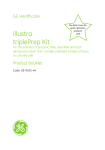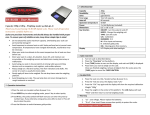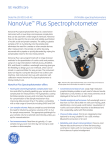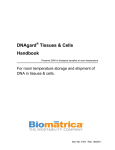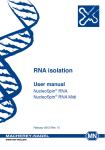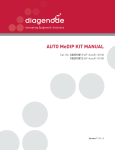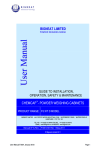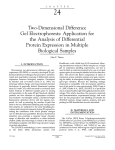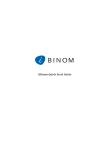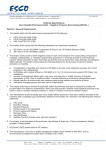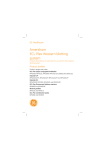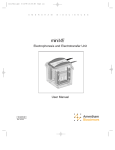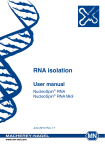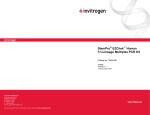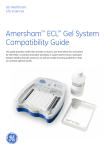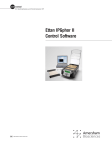Download illustra triplePrep Kit - GE Healthcare Life Sciences
Transcript
GE Healthcare illustra triplePrep Kit See back cover for quick reference protocol card For the isolation of genomic DNA, total RNA and total denatured protein from a single undivided sample of tissue or cultured cells Product booklet Code: 28-9425-44 Page finder 1. Legal 4 2. Handling 2.1. Safety warnings and precautions 2.2. Storage 2.3. Expiry 5 5 6 6 3. Components 3.1. Kit contents 3.2. Materials to be supplied by user 3.3. Equipment needed 7 7 9 10 4. Description 4.1. Introduction 4.2. The basic principle 4.3. Product specifications 4.4. Typical output 11 11 13 18 20 5. Protocol 23 5.1. Preparation of working solutions 24 5.2. Protocol for isolation of DNA, RNA and Protein from tissue, cultured cells and cells from whole blood 26 6. Appendices 6.1. Tissue homogenization considerations 6.2. Estimation of cell density 6.3. DNA handling and quantification 6.4. RNA handling and quantification 6.5. Protein handling and quantification 6.6. DNA contamination removal in eluted RNA 6.7. RPM to RCF calculation 6.8. Troubleshooting guide 6.9. Related products 2 37 37 39 40 41 42 43 44 45 53 7. References 57 Quick Reference Protocol Card Back Cover Tear off sheet containing protocols for the experienced user isolating DNA, RNA and protein from tissue or cultured cells. 3 1. Legal Product use restriction The components of the illustra™ triplePrep Kit have been designed, developed and sold for research purposes only. They are suitable for in vitro use only. No claim or representation is intended for its use to identify any specific organism or for clinical use (diagnostic, prognostic, therapeutic, or blood banking). It is the responsibility of the user to verify the use of illustra triplePrep Kit for a specific application as the performance characteristic of this kit has not been verified to any specific species. GE, imagination at work and GE monogram are trademarks of General Electric Company. illustra, Ficoll-paque, PuReTaq, Ready-To-Go, HyBond, Deep Purple, ECL, CyDye, Rainbow and NanoVue are trademarks of GE Healthcare companies. All third party trademarks are the property of their respective owners. © 2008–2009 General Electric Company-All rights reserved. Previously published 2008. Date of revision May 2009. All goods and services are sold subject to the terms and conditions of sales of the company within GE Healthcare which supplies them. A copy of the terms and conditions is available upon request. Contact your GE Representative for the most current information http://www.gelifesciences.com GE Healthcare UK Limited. Amersham Place, Little Chalfont, Buckinghamshire. HP7 9NA UK. 4 2. Handling 2.1. Safety warnings and precautions Warning: This protocol requires the use of Ethanol and Acetone. Warning: For research use only. Not recommended or intended for diagnosis of disease in humans or animals. Do not use internally or externally in humans or animals. Lysis buffer type 15 and Protein precipitation buffer type 1 are harmful if ingested, inhaled, or absorbed through the skin, and can cause nervous system disturbances, severe irritation, and burning. They are destructive to the eyes, skin, and mucous membranes of the upper respiratory tract. Gloves should always be worn when handling these solutions. All chemicals should be considered as potentially hazardous. Only persons trained in laboratory techniques and familiar with the principles of good laboratory practice should handle these products. Suitable protective clothing such as laboratory overalls, safety glasses, and gloves should be worn. Care should be taken to avoid contact with skin or eyes; if contact should occur, wash immediately with water (see Material Safety Data Sheet and/or Safety Statements for specific recommendations). Use of this product with cells, tissue or tissue products should be considered biohazardous. Follow appropriate safety procedures while using this kit and when handling DNA, RNA and protein isolated from these sources. Waste effluents from this kit should be decontaminated with bleach or by a detergent-based method. Decontamination with bleach may be reactive, resulting in 5 foam and emission of ammonia gas, and should be carried out in an exhaust hood. Consult local safety regulations for disposal of all waste. 2.2. Storage Store lyophilized RNase-free DNase I at 4°C on arrival to extend its shelf life. Once reconstituted in RNase-free water, aliquot and store DNase at -20°C. Avoid vigorous mixing of the enzyme. All other kit components should be stored at room temperature (20–25°C). Storage at lower temperatures may cause precipitation of salts. 2.3. Expiry For expiry date please refer to outer packaging label. DNase reconstituted in RNase-free water is stable for 6 months when stored at -20°C 6 3. Components 3.1. Kit contents Identification Pack Size Cat. No. Lysis buffer type 15 (blue colored cap) 10 purifications 50 purifications sample pack 28-9425-44 75 ml 75 ml (Remove (Remove aliquot and add aliquot and add 2-Mercaptoethanol 2-Mercaptoethanol to aliquot before to aliquot before use) use) 12 ml 12 ml Wash buffer (Add 48 ml Ethanol (Add 48 ml Ethanol type 6 before 1st time before 1st time (yellow colored use) use) cap) Elution buffer 12 ml 12 ml type 5 (silver colored cap) Elution buffer 7.5 ml 7.5 ml type 9 (pink colored cap) Protein 2 × 17.5 ml 2 × 17.5 ml precipitation buffer type 1 (green colored cap) DNase I 1 vial 1 vial (black colored cap) 7 DNase reaction buffer type 1 (red colored cap) illustra mini columns (DNA, orange o-ring) illustra mini columns (RNA, pink o-ring) Collection tubes 1.4 ml 1.4 ml 10 50 10 50 1 × 50 4 × 50 Refer to the Certificate of Analysis for a complete list of kit components at http://www.gelifesciences.com. GE Healthcare supplies a wide range of buffer types across the illustra nucleic acid and TRAP protein purification range. The composition of each buffer has been optimized for each application and may vary between kits. Care must be taken to only use the buffers supplied in the particular kit you are using and not use the buffers supplied in other illustra kits (e.g. the Lysis buffer type 15 supplied in the illustra triplePrep Kit is not the same as Lysis buffers type 1 & 4 supplied in the illustra tissue & cells genomicPrep Mini Spin Kit). In order to avoid confusion and the accidental switching of buffers between kits, a numbering system has been adopted that relates to the entire range of buffers available in the illustra purification range. For example there are currently 15 Lysis buffers in the illustra range, 6 Wash buffers and 9 Elution buffers, denoted by Lysis buffer type 1–15, Wash buffer type 1–6 and Elution buffer type 1–9 respectively. Please ensure you use the correct type of Lysis, Wash and Elution buffer for your purification. 8 3.2. Materials to be supplied by user Chemicals: • 2-Mercaptoethanol (14.3 M or >98%) • Absolute Ethanol (molecular biology grade) • Nuclease –free Water (molecular biology grade) • Absolute Acetone (molecular biology grade) • 2-D DIGE buffer (for easy protein re-suspension): 7 M Urea, 2 M Thiourea, 4% (v/v) CHAPS, 30 mM Tris-HCl, pH 8.5 (Chemicals in 2-D DIGE buffer are supplied by GE Healthcare; see Section 5.1 page 24 for preparation details) Protein resuspended in 2-D DIGE buffer can be used for SDS-PAGE or Western Blot by mixing with 1 volume of 20% SDS (Sodium dodecyl sulfate). Add appropriate sample loading buffer (i.e. 1 volume of 2× Laemmli buffer) and incubate at 70°C for 10 minutes before gel loading. • Ficoll-Paque™ Plus for the in vitro isolation of lymphocytes from freshly drawn blood (supplied by GE Healthcare) • Optional: Phosphate buffered saline (PBS) if processing fresh cultured cell lines • Optional: Freshly-drawn citrated blood (>20 ml) for the preparation of lymphocytes on Ficoll-Paque PLUS • Optional: Balanced salt solution if processing freshly-prepared lymphocytes • Optional: Liquid nitrogen • Optional: Protein concentration determination reagents e.g. 2-D Quant Kit (supplied by GE Healthcare) Disposables: • 1.5 ml DNase & RNase-free microcentrifuge tubes • DNase & RNase-free pipet tips 9 3.3. Equipment needed • Microcentrifuge that accommodates 1.5 ml microcentrifuge tubes and can spin at 16 000 × g or higher. • Vortex mixer • Rotor-stator homogenizer or mortar and pestle. • Optional: Nuclease-free 20-gauge needle and syringe (1 ml) if using mortar & pestle or for cell lysate homogenization. 10 4. Description 4.1. Introduction The illustra triplePrep Kit is designed for the rapid extraction of genomic DNA, total RNA and total denatured protein from a single undivided sample starting from as little as 1 mg of animal tissue, 0.3 million cultured mammalian cells or 107 freshly-prepared lymphocytes. The protocols for extraction from both tissues and cell lines utilize the same buffers. Although the protocols are rapid, they have been designed to minimize shearing of genomic DNA, maintain the integrity of the RNA and maximize proteome representation. The entire procedure can be completed in as little as 45 minutes to yield genomic DNA, total RNA and denatured total protein which are compatible with most molecular biology applications. These are summarized in Table 1. Table 1. Analyte Downstream applications Genomic DNA Restriction enzyme digestion, PCR, sequencing, array CGH Total RNA RT-PCR, cDNA synthesis, Expression array Total Protein SDS-PAGE, Western Blotting, 2-D DIGE, LCMS DNA, RNA and protein have been successfully isolated from a range of tissue types such as liver, kidney, spleen, brain, lung and intestine and freshly-prepared lymphocytes from blood, and the cell lines HeLa, NIH-3T3, CHO-K1 and HEK-293. Tissue amounts ranging from 1–20 mg can be used for each preparation. Cells amounts ranging from 0.3–5 million cells can be used for each preparation. 107 lymphocytes isolated on Ficoll-Paque PLUS are required for nucleic acid and protein preparation. 11 Although the kit is designed to isolate DNA, RNA and Protein, users may select to only isolate 2 out of 3 analytes when following the protocol. As shown in Fig 1, the DNA purification step does not affect RNA and protein isolation; RNA purification step does not affect protein isolation. RNA in the flowthrough is stable for about 30 minutes at room temperature or 60 minutes on ice depending on sample types. Users may purify RNA immediately at this point by following Step 6 before returning to Step 3 for DNA purification to prevent potential RNA degradation. DNA bound to the mini column is stable for at least 30 minutes at room temperature. Experienced users may also simultaneously purify DNA and RNA first to save time and ensure RNA quality when DNase treatment is not needed. The illustra triplePrep Kit conveniently provides a flexible lysis buffer for the long-term storage of samples, avoiding the need for costly stabilization reagents. Following sample disruption, samples can be stored in Lysis buffer type 15 at -80°C for 6 months or up to 4 hours at room temperature. 1. Sample Homogenization & Lysis Fig 1. 2. DNA binding 3. DNA wash 1 6. RNA binding 4. DNA wash 2 7. DNase treatment (optional) 5. DNA elution 8. RNA wash DNA Purification 9. RNA elution RNA Purification 10. Protein precipitation 11. Protein wash 12. Protein resuspension Protein Isolation The kit contains sufficient reagents and columns for 50 (28-9425-44) purifications of DNA, RNA and protein from 5 mg animal tissue or 1 million cultured cells. 12 4.2. The basic principle Use of the illustra triplePrep Kit involves the following steps: Fig 2 1. Sample homogenization & lysis 2. DNA binding 3. DNA wash 1 4. DNA wash 2 RNA and Protein in flowthrough 5. DNA elution 6. RNA binding 13 6. RNA binding (continued) 7. DNase treatment (optional) 8. RNA wash Protein in flowthrough 9. RNA elution 10. Protein precipitation 11. Protein wash 12. Protein resuspension 14 Table 2. Step Comments Component 1. Sample homogenization and lysis Tissue and cells are lysed in presence of Lysis buffer type 15 (with 2Mercaptoethanol) Lysis buffer type 15 (add 1% 2-Mercaptoethanol) 2. DNA binding Chaotropic salt in Lysis buffer type 15 promotes the binding of DNA to the silica membrane. illustra mini columns (DNA, orange o-ring) 3. DNA wash 1 Lysis buffer type 15 removes contaminants from membrane bound DNA The ethanolic Wash buffer type 6 removes residual salts and dries the silica membrane at the same time. DNA is eluted in a low ionic strength buffer. Acetone promotes the binding of total RNA to the silica membrane in the presence of chaotropic salt in Lysis buffer type 15 On-column DNase digestion removes residual genomic DNA bound to the silica membrane Lysis buffer type 15 4. DNA wash 2 5. DNA elution 6. RNA binding 7. DNase treatment (optional) 15 Wash buffer type 6 Elution buffer type 5 Acetone (user supplied) illustra mini columns (RNA, pink o-ring) DNase I and DNase reaction buffer type 1 Step 8. RNA wash 9. RNA elution 10. Protein precipitation 11. Protein wash 12. Protein resuspension Comments The ethanolic Wash buffer type 6 removes residual salts and dries the silica membrane at the same time. RNA is eluted in RNasefree water Acid and salt based Protein precipitation buffer type 1 Water solubilizes and removes acid and salt from protein pellet Urea and detergent in 2-D DIGE buffer ensure complete protein pellet solubilization. Component Wash buffer type 6 Elution buffer type 9 Protein precipitation buffer type 1 Water (user supplied) 2-D DIGE buffer (user supplied) 1st time users of triplePrep should follow the detailed protocol in section 5. The quick reference protocol is for experienced users only. It is highly recommended that when processing a type of tissue or cell for the first time, users should start with 5 mg tissue or 1 million cells. Alter the input sample amount depending on initial results. As shown in Fig 2, sample is lysed in Lysis buffer type 15, which contains large amounts of chaotropic salts. This lysis buffer immediately inactivates DNase, RNases and proteases, which are present in virtually all biological materials, and creates appropriate binding conditions that favor adsorption of DNA to the silica membrane. The DNA, RNA and protein (especially RNA) within tissue and cells are vulnerable to attack by both endogenous enzymes and those in the general laboratory environment. 16 Use fresh material whenever possible. Where this is not possible, it is important that samples are flash frozen in liquid nitrogen immediately and stored at -80°C or stored in a stabilizing agent. Samples should always be stored at -80°C. Never allow tissues to thaw before addition of Lysis buffer type 15 and disrupt samples in liquid nitrogen, if possible. DNA is bound to the 1st mini column (orange o-ring) in the presence of a chaotropic solution. Contaminants are removed from DNA with Lysis buffer type 15 and Wash buffer type 6. DNA is eluted with Elution buffer type 5. Total RNA and protein do not bind to the 1st mini column and are collected in the flowthrough. Acetone is added to the flowthrough and total RNA is bound to the 2nd mini column (pink o-ring). An optional on-column DNase-digestion step may be undertaken at this point (see Step 7, Page 33 for details of when to perform a DNase digestion). Contaminants are removed from the total RNA with Wash buffer type 6 and total RNA is eluted with Elution buffer type 9. Purified RNA should be treated with care because RNA is very sensitive to trace contaminations of RNase, often found on general labware, fingers and dust. Wear gloves at all times during the preparation. Change gloves frequently. Wipe down all laboratory surfaces with alcohol wipes regularly. To preserve stability, keep the isolated total RNA frozen at -80°C for long-term storage. Protein does not bind to the RNA mini column and is collected in the flowthrough. A rapid protein precipitation step is undertaken and the protein sample can then be washed and resuspended in 2-D DIGE buffer for a 2-D DIGE study or SDS-PAGE and Western Blotting. 17 4.3. Product specifications Figures shown are expected performance of illustra triplePrep Kit shown in Table 3. Table 3 Sample Type Rat Liver HeLa Cells Sample input amount 1–20 mg 0.3–5 million Genomic DNA yield 1–3 µg (per mg tissue) 4–12 µg (per million cells) Total RNA yield 3–7 µg (per mg tissue) 10–15 µg (per million cells) 80–160 µg (per mg tissue) 100–200 µg (per million cells) Protein yield > = 1.7 Genomic DNA purity (A260/A280) Genomic DNA size > = 15 kb Total RNA purity (A260/A280) > = 1.9 Total RNA quality (RIN) 8.0–10 Total RNA quality 28s:18s 1.5–2.5 Time/preparation (excluding lysis) 45–60 minutes Note:The mini column with orange o-ring has a binding capacity of 20 µg for genomic DNA. About 15 µg of DNA can be eluted on 1st elution if 20 µg or more DNA is present in the crude lysate. DNA yield will not be increased when more than 20 µg of DNA is processed. The mini column with pink o-ring has the binding capacity of 60 µg of total RNA. About 45 µg of total RNA can be eluted on 1st elution if 60 µg or more total RNA is present in the flowthrough. RNA yield will 18 not be increased when more than 60 µg of RNA is processed. Loading the system with sample containing more nucleic acids than the columns can bind will not increase yield and sometimes may even lower the quality and purity of purified nucleic acids. For example, around 15 µg of genomic DNA and 45 µg of total RNA usually can be isolated from 10 mg of rat liver, which contains 20–25 µg of genomic DNA and 50–70 µg of total RNA. However, DNA and RNA yield will not be doubled if 20 mg of rat liver is processed due to the capacity of DNA and RNA column being reached. Excess DNA, that does not bind to the 1st column will flow through into the RNA binding and elution steps. If user has large amounts of tissue or cells, it is highly recommended to split the samples and process as several samples for better quality and yield of nucleic acids. As protein is precipitated out without binding to any columns, yield of protein is relatively linear to sample input amount (i.e. If 100 µg of protein can be isolated from 1 mg of certain type of tissue, then 2000 µg of protein is expected from 20 mg of this type of tissue). 19 4.4. Typical output Table 4. Typical yields and purities of genomic DNA, total RNA and total Protein from different tissue and cells Cell DNA RNA HeLa NIH-3T3 CHO-K1 HEK-293 Cell input amount (million) 1 1 1 1 Yield ( µg) 8.5 9.5 4.4 9.1 Purity (A260/ A280) 1.9 1.9 1.9 1.9 Yield ( µg) 13.7 7.9 6.6 10.1 Purity (A260/ 2.1 2.1 2.0 2.0 Yield ( µg) 139 127 77 139 Tissue Liver Brain Heart Kidney Lung Spleen 10 10 10 10 10 10 Disruption difficulty Easy Easy Hard Med Med Med A280) Protein Tissue input amount (mg) DNA RNA Yield ( µg) 14.6 6.8 9.8 17.0 15.5 18.8 Purity (A260/ A280) 1.9 1.8 1.9 1.9 1.8 1.8 Yield ( µg) 44 5.5 2.9 4.4 8.8 18.9 Purity (A260/ 2.1 2.0 1.9 1.9 2.0 2.1 A280) Need DNase Protein Yield ( µg) Yes No No Yes Yes Yes 1460 746 923 897 592 510 Yield and purities of genomic DNA total RNA and total Protein may vary depending on nature and condition of input sample and user. 20 Fig 3. Genomic DNA from 1 million HeLa cells was isolated with triplePrep kit and evaluated using 0.8% agarose gel electrophoresis. 2 µl of genomic DNA (100 µl elution) was loaded in each well. Lamda DNA Ladder 23 kb Fig 4. Total RNA from 10 mg rat liver was isolated with triplePrep kit and evaluated using the Agilent 2100 bioanalyzer. The triplePrep kit produces high quality RNA; the 28 s: 18 s = 2.2, RNA Integrity Number (RIN) = 9.8 28s 18s 21 Fig 5. Total protein from 10 mg rat liver was isolated with triplePrep kit and evaluated using a. Western Blot (β-Actin) and b. 2-D DIGE Western blot (Rat liver) β-Actin (42 kDa) a. b. Overlaid image (yellow) of triplePrep (green) and reference gel (red) As seen more spots are detected by triplePrep method (green spots) 22 5. Protocol Use of icons The key below describes the purpose of the icons used throughout the protocol booklet. This icon is used to highlight particularly critical steps within the protocol that must be adhered to. If this advice is not followed it will have a detrimental impact on results. This icon is used to highlight technical tips that will enhance the description of the step. These tips may indicate areas of flexibility in the protocol or give a recommendation to obtain optimum performance of the kit. This icon is used to highlight convenient points that the protocol can be stopped. Important notes • External factors (sample nature, storage condition etc.) may affect the quality and yield of isolated genomic DNA, total RNA and total protein. • 1st time users of triplePrep should follow the detailed protocol in Section 5. The quick reference protocol is for experienced users only. • Do NOT overload the columns with too much starting material or too much nucleic acid rich lysate. It is highly recommended that when processing a type of tissue or cell for the first time, users should start with small amount of sample input (5 mg tissue or 1 million cells). Alter the input sample amount depending on initial results. • It is highly recommended that users determine the amount of starting material, especially during the first time processing certain types of sample with triplePrep kit. 23 • It is important to load only 350 µl of initial homogenized sample in Lysis buffer type 15 onto the genomic DNA mini column. The RNA binding and protein precipitation have been optimized based on 350 µl of lysate being used. • Perform all steps of the procedure (including incubation and flowthrough storage) at room temperature, unless instructed otherwise. 5.1. Preparation of working solutions See Sections 3.2 & 3.3 for Materials & Equipment to be supplied by user. Lysis buffer type 15 For each sample being processed, aliquot 350 µl of Lysis buffer type 15 to a fresh DNase & RNase-free tube and add 3.5 µl of 2-Mercaptoethanol. Prepare a fresh aliquot, based on total number of samples being processed, each time the triplePrep kit is used. 2-Mercaptoethanol is not stable in Lysis buffer type 15. Do NOT add 2-Mercaptoethanol directly to the kit bottle of Lysis buffer type 15. Lysis buffer type 15 without 2-Mercaptoethanol is required during the protocol Wash buffer type 6 Add 48 ml Absolute Ethanol to Wash Buffer type 6 before use. Mix by inversion and indicate on the label, by ticking the box, that this step has been completed. Store upright and at room temperature (20–25°C). DNase I Add 540 µl of RNase-free water to the DNase vial and incubate for 1 minute at room temperature. Aliquot and store at -20°C. Reconstituted DNase is stable for 6 months when stored at -20°C. Avoid vigorous mixing of the enzyme. Do NOT vortex. Invert vial to mix. 24 Protein pellet resuspension buffer (user supplied). The 2-D DIGE buffer is a suitable buffer to resuspend protein pellets obtained with the illustra triplePrep kit. Preparation instruction is shown in Table 5. Table 5. 2-D DIGE buffer preparation 100 ml Scale Final concentration Distilled water 40 ml Urea 42.0 g Thiourea 15.2 g 2M Tris-HCI 0.36 g 30 mM CHAPS (3-3-Cholamidopropyl) 4.0 g 4% 7M dimethylammonio]-1- propanesulfonate) Mix well (do not heat over 37°C). Adjust final pH to 8.5 (8.0–9.0) and adjust to final volume with distilled water Dispense into 5 ml aliquots and store at -20°C with a 3 month expiry date (if using for 2-D DIGE study) Protein resuspended in 2-D DIGE buffer can be used for 2-D DIGE directly. Protein resuspended in 2-D DIGE buffer can be used for SDSPAGE/Western Blotting by mixing with 1 volume of 20% SDS. Add appropriate sample loading buffer (i.e. 1 volume of 2X Laemmli buffer) and incubating at 70°C for 10 minutes before gel loading. 5% SDS or Laemmli buffer alone are not recommended for protein resuspension due to the significant reduction in protein solubilization efficiency. The 2-D Quant Kit (supplied by GE Healthcare) is recommended for protein concentration quantification. Please note 2-D DIGE buffer is not compatible with Bicinchoninic Acid (BCA) or Bradford protein quantification assays. Alternatively, 7 M Urea can be used for protein resuspension and further diluted to less than 3 M to be compatible with BCA or Bradford assays. 25 5.2. Protocol for isolation of DNA, RNA and Protein from tissue, cultured cells and cells from whole blood Note: The illustra triplePrep Kit is not suitable for the preparation of gDNA, total RNA and total protein from plasma or serum. Freshly collected whole blood can be used for the isolation of DNA, RNA and total protein when the lymphocytes are isolated and used as source material. Sample homogenization & lysis The complete disruption and homogenization of animal tissue is critical. Animal tissues are often solid and must therefore be broken up mechanically as well as lysed. Depending on the disruption method, the viscosity of the lysed sample has to be reduced further for optimal results. It is essential for efficient nucleic acid preparation that all the nucleic acid contained in the sample is released from the cells by disruption and that the viscosity of the sample is reduced by homogenization. Following homogenization, the tissue should be uniformly suspended in solution and free of any visible clumps. Minimize any temperature increases at this stage. A rotor-stator homogenizer is recommended due to its fast tissue disruption speed, high recovery and consistency. See section 6.1 for further information on tissue homogenization. Fresh animal tissue should be either processed immediately or snap frozen in liquid nitrogen. The triplePrep Kit is compatible with available stabilization reagents, but RNA yield may be impacted. The illustra triplePrep Kit conveniently provides a flexible solution to the long term storage of samples, avoiding the need for costly stabilization agents. Following sample disruption, samples can be stored in Lysis buffer type 15 at -80°C for 6 months or up to 4 hours at room temperature. 26 Frozen tissue should not be thawed but processed immediately in Lysis buffer type 15 containing 2-Mercaptoethanol during simultaneous mechanical disruption, e.g., with a rotor-stator homogenizer. This ensures that the RNA is not degraded by RNase before the preparation has started. Fresh cultured cells can be lysed after pelleting or lysed directly on the culture plate (for detailed protocol see note in Step 1 (iii)). For the isolation of DNA, total RNA and total protein, uses are referred to instructions included in the product insert describing the fresh preparation of lymphocytes on Ficoll-Paque PLUS. 20 ml of citrated whole blood should be precessed. Following lymphocyte isolation, cells should be counted. At least 107 cells should be used for isolating gDNA, total RNA and protein using the illustra triplePrep Kit. Lymphocytes should be pelleted and re-suspended in PBS as described in Step 1 (iii) (cell homogenization and lysis, see page 28). Frozen cell pellets should not be thawed but processed immediately in Lysis buffer type 15 containing 2-Mercaptoethanol. Protocols are provided for use of a rotor-stator homogenizer or a mortar and pestle combined with a needle and syringe. Either protocol may be followed when processing tissue samples. A separate protocol is provided when processing cultured cells. If using any instrument for tissue disruption and homogenization, ensure that you are familiar with the operating procedure by referring to its user manual and handbook. Some instruments may require use of greater than 350 µl Lysis buffer type 15. Please use the volume recommended by your instrument and adjust sample input accordingly. Load only 350 µl of crude lysate to the 1st mini column (orange o-ring). 27 1 (i) Tissue homogenization & lysis using a rotor-stator homogenizer a. Select proper sized generator and suitable sized tube for homogenization of a small volume of sample (i.e., 350 µl or more) b. Add 350 µl of Lysis buffer type 15 containing 2-Mercaptoethanol to the tube. c. Add tissue sample (1–20 mg). d. Homogenize the tissue according to instrument’s user manual. Visually inspect the prepared homogenate and ensure thorough homogenization (No tissue pieces should be visible). Take care to keep the rotor tip submerged in order to avoid excess foaming. If foaming occurs during homogenization, let the homogenate stand at room temperatures for 3–5 minutes. e. Proceed immediately to Step 2 or store at -80°C for up to 6 months. Homogenized sample in Lysis buffer type 15 containing 2-Mercaptoethanol may be stored at -80°C for up to 6 months. 1 (ii) Tissue homogenization & lysis using a mortar & pestle and a needle & syringe a. Dispense sufficient liquid nitrogen to cover the bottom of a mortar. Immediately place tissue (1–20 mg) in liquid nitrogen, and grind the sample to a fine powder in the presence of liquid nitrogen. 28 b. Allow the liquid nitrogen to evaporate but do not allow the tissue to thaw. c. Add 350 µl of Lysis buffer type 15 containing 2-Mercaptoethanol and grind further with the pestle until no visible tissue pieces are present. d. Pass lysate at least 5 times through a DNase& RNase-free 20-gauge needle fitted with 1 ml sterile syringe. e. Proceed immediately to Step 2 or store at -80°C for up to 6 months. Homogenized sample in Lysis buffer type 15 containing 2-Mercaptoethanol may be stored at -80°C for up to 6 months. 1 (iii) Cell homogenization & lysis a. Pellet up to 5 × 106 cultured cells, or107 lymphocytes, prepared on Ficoll-Paque PLUS in a 1.5 ml microcentrifuge tube by centrifugation for 1 minute at 11 000 × g. b. Completely remove the supernatant by aspiration. c. Wash the pellet with 500 µl PBS d. Spin for 1 minute at 11 000 × g. e. Completely remove the supernatant by aspiration. Cell pellet can be stored at -80°C for up to 12 months. f. Add 350 µl of Lysis buffer type 15 containing 2-Mercaptoethanol. 29 g. Pipet up and down to resuspend the cell pellet. h. Homogenize by passing lysate at least 5 times through a DNase & RNase-free 20-gauge needle fitted with 1 ml sterile syringe. f. Proceed immediately to Step 2 or store at -80°C for up to 6 months. Homogenized sample in Lysis buffer type 15 containing 2-Mercaptoethanol may be stored at -80°C for up to 6 months. Cells grown in monolayer in a 6-well plate can be lysed directly. Remove media and quickly wash cells with 500 µl cold PBS. Remove PBS and add 350 µl of Lysis buffer type 15 containing 2-Mercaptoethanol per well of the 6-well plate. Incubate for 1 minute at room temperature. Pipet up and down several times to resuspend and homogenize using a needle & syringe as above. Genomic DNA isolation 2 DNA binding a. Place a new mini column (orange o-ring) into a 2 ml Collection tube (provided). b. Transfer the homogenized lysate from Step 1 (350 µl) to the column. 1 min 11 000 × g c. Spin for 1 minute at 11 000 × g. d. Save the flowthrough for RNA and Protein 30 isolation at room temperature. (Refer to Step 6 or Step 10 for further processing) e. Transfer the column to a new 2 ml Collection tube (provided). Proceed to Step 3. Should the column clog, repeat Step 2c 1–2 times. If it still clogs, initial sample amount should be reduced. Users may purify RNA immediately at this point by following Step 6 before returning to Step 3 for DNA purification to prevent potential RNA degradation. Experienced users may also simultaneously purify DNA and RNA by performing Steps 3 and 6, 4 and 8, 5 and 9 at the same time when DNase treatment is not needed. 3 DNA wash 1 a. Add 500 µl of Lysis buffer type 15 (without 2-mercaptoethanol) to the column. b. Spin for 1 minute at 11 000 × g. Discard the flowthrough. 500 µl Lysis buffer type 15 1 min 11 000 × g c. Place the column back into the same Collection tube. 4 DNA wash 2 a. Add 500 µl of Wash buffer type 6 column. to the b. Spin for 1 minute at 11 000 × g. Discard the Collection tube and its contents. 31 500 µl Wash buffer type 6 1 min 11 000 × g Please check that no residual flowthrough remains in the column outlet. If any remains, empty the Collection tube, put the column back, repeat Step 4b. c. Transfer the column to a fresh DNase-free 1.5 ml microcentrifuge tube (user supplied). 5 DNA elution a. Add 100 µl of Elution buffer type 5 center of the column. to the b. Spin for 1 minute at 11 000 × g to collect the purified DNA as the flowthrough in the 1.5 ml microcentrifuge tube. c. Discard the column and store purified DNA at -20°C or -80°C. If not subjected to repeated freeze-thaw cycles, DNA is stable for 12 months. d. Proceed immediately to Step 6 to isolate RNA. Total RNA isolation 6 RNA binding a. Place a new mini column new Collection tube (pink o-ring) in a b. Add 350 µl of Absolute Acetone to the flowthrough from Step 2d. Mix well by pipetting up and down several times. Transfer the entire mixture to the mini column . 32 1 min 11 000 × g c. Spin for 1 minute at 11 000 × g. d. Save the flowthrough for protein isolation at room temperature. (Refer to Step 10 for further processing) 1 min 11 000 × g e. Transfer the column to a new Collection tube (provided). Proceed to Step 7 or Step 8 as required. 7 DNase treatment (optional) triplePrep Kit’s mini column with orange o-ring has the binding capacity of 20 µg DNA. Crude lysate containing more than 20 µg DNA (for example, when 10 mg rat liver or 3 million HeLa Cells are processed) may require use of DNase to remove residual genomic DNA in the isolated RNA. a. In a RNase-free microcentrifuge tube, add 10 µl of reconstituted DNase I , 20 µl of DNase reaction buffer type 1 and 70 µl RNase-free water. Mix by flicking the tube. Do not vortex. b. Apply 100 µl of diluted DNase directly on the center of membrane of the column. Incubate for 10 minutes at room temperature. Proceed to Step 8. 8 RNA wash a. Add 500 µl of Wash buffer type 6 column. 33 to the 500 µl Wash buffer type 6 b. Spin for 1 minute at 11 000 × g. Discard the Collection tube and its contents. 1 min 11 000 × g Please check that no residual flowthrough remains in the column outlet. If any remains, empty the Collection tube, put the column back, repeat Step 8b. c. Transfer the column to a fresh RNase-free 1.5 ml microcentrifuge tube (user supplied). 9 RNA elution a. Add 100 µl Elution buffer type 9 center of the column. to the 100 µl Elution buffer type 9 50 µl or less of Elution buffer type 9 can be used for achieving more concentrated RNA elution. b. Spin for 1 minute at 11 000 × g to collect the purified total RNA as the flowthrough in the Collection tube. c. Discard the column and store purified RNA at -80°C. Purified RNA is stable for up to 12 months. Proceed to Step 10. Total protein isolation 10 Protein precipitation a. Transfer the entire flowthrough (approximately 600 µl) from Step 6d to a new 1.5 ml microcentrifuge tube. Flowthrough containing total protein can be stored at -80°C for up to 6 months. b. Add 600 µl of Protein precipitation buffer type 1 . 34 1 min 11 000 × g c. Mix vigorously and incubate for 5 minutes at room temperature to precipitate the proteins. 10 min 16 000 × g d. Spin for 10 minutes at full speed (minimum 16 000 × g). e. Carefully remove as much supernatant as possible by pipetting or decanting. 11 Protein wash a. Add 1 ml of distilled water to protein pellet (user supplied). b. Actively disperse protein pellet by pipetting up and down at least 5 times. c. Spin for 1 minute at full speed (minimum 16 000 × g). Position tubes within the microcentrifuge with cap hinge facing outward. Protein pellet will then form at the bottom of the tube directly beneath the cap hinge. A second water wash may be repeated if further removal of residual salt in protein pellet is needed (e.g. 2-D DIGE or LCMS experiments) d. Carefully remove as much supernatant as possible by pippeting or decanting. 12 Protein resuspension a. Add 50–500 µl of 2-D DIGE buffer (see Page 25 Table 5 for preparation instruction) b. Incubate for 5 minutes at room temperature. 35 1 min 16 000 × g The 2-D Quant Kit (supplied by GE Healthcare) should be used to determine protein concentration. Please note 2-D DIGE buffer is not compatible with BCA or Bradford assays. Alternatively, 7 M Urea can be used for protein resuspension and further diluted to less than 3 M to be compatible with BCA or Bradford assays Protein resuspended in 2-D DIGE buffer can be used for SDS-PAGE by mixing with 1 volume of 20% SDS. Add appropriate sample loading buffer (i.e. 1 volume of 2× Laemmli buffer) and incubating at 70°C for 10 minutes before gel loading. 36 6 Appendices 6.1. Tissue homogenization considerations The complete disruption and homogenization of animal tissue is critical. Following homogenization, the tissue should be uniformly suspended in solution and free of any visible clumps. It is highly recommended that tissue is disrupted and homogenized as quickly as possible while minimizing any temperature increase. If using any instrument for tissue disruption and homogenization, ensure that you are familiar with the operating procedure, by referring to its user manual and handbook. Some instruments may require use of greater than 350 µl Lysis buffer type 15. Please use the volume recommended by your instruments. Load only 350 µl of crude lysate to genomic DNA mini column. • Rotor-stator homogenizer A rotor-stator homogenizer can simultaneously disrupt and homogenize most animal tissues and cells in less than 60 seconds. It has moderate efficiency. It generates negligible heat during operation. The major drawback for a rotor-stator homogenizer is it does not work well with difficult-to-lyse samples. The cell/tissue suspension is drawn into the apparatus by a rotor sited within a stator (hollow tube). The suspension is then centrifugally thrown outward to exit through slots or holes on the tip of the stator. When the rotor spins, it sucks the sample up and cuts it while it is rotating. When the sample is pushed out of the slots, it is cut further. Outside (of the slots), the sample meets a pressure differential, which shears the cells even further. Most laboratory rotor-stator homogenizers are top driven at a speed of 8000–60 000 rpm. The cell suspension is recycled several times. • Mechanical agitation device 37 A common laboratory-scale mechanical method for cell disruption that uses glass or ceramic beads and a high level of agitation. It is normally used for samples are tough to disrupt (yeast, spores, and micro algae). It has moderate efficiency. The major drawbacks for a mechanical agitation device are it has large variability in product yield and purity and occasional problems with foaming and sample heating. At the lowest levels of the technology, the beads are added to the cell suspension in a tube and the sample is mixed on a common laboratory vortex mixer. This process works for easily disrupted cells, is inexpensive, and multiple samples can be conveniently processed. The more sophisticated level, bead-based methods use a closed container, holding the sample and the beads, with an electric motor to provide vigorous agitation. When larger samples are processed, some form of cooling is provided (typically liquid CO2) as the sample heats significantly due to the extreme agitation. Another configuration uses an inert, rapidly rotating rotor in a small container containing the cells and beads. • Mortar and pestle style grinders Grinding with mortar and pestle is the most commonly used technique for disruption of animal tissue. The technique tends to be a gentle cell disruption method (significantly gentler than e.g. sonication). However, this technique is laborious, slow and usually inefficient. It generates heat so cooling is necessary. The grinders consist of a grinding container (mortar) and a pestle. The cells are sheared between the wall of the container and the edge of the pestle. This method requires careful attention to conditions such as force and cooling. Tissue shall be snap frozen in liquid nitrogen and disrupted without thawing. Extra steps of homogenization are required after disruption. The illustra triplePrep Kit recommends use of a needle and syringe for homogenization after grinding. 38 6.2. Estimation of cell density It is recommended not to exceed 5 × 106 cells when purifying genomic DNA from mammalian cultured cells. DNA yields drop when silica columns begin to experience clogging (seen at 1 × 107 cells). Cell density should be estimated using an automated cell counter (e.g. Coulter) or individual cells should be counted under a microscope using a standard hemocytometer (Hausser Scientific/VWR, #1483). If cell count exceeds 5 × 106 cells/ml, cells should be split into two DNA preparations. Below are guidelines for measuring cell density using a hemocytometer. 1. Clean a hemocytometer and the short coverslip thoroughly and wipe clean with ethanol. 2. If working with adherent cells, trypsinize the cells and wash once with PBS. Otherwise pellet the cells (5000 rpm for 1 minute) such as those grown in suspension. 3. Resuspend cells in appropriate volume of PBS to yield roughly 1 × 106 cell/ml. For example, mammalian cells grown inside a 25 cm2 flask to confluence yield approximately 2.5 × 106 cells per flask (Visit Corning web site at http://catalog2.corning.com/ Lifesciences/). If a 25 cm2 flask was used add 2.5ml of PBS. Make sure cells are completely resuspended without any visible clumps. 4. Add 10 µl of resuspended cells to two chambers of hemocytometer separately (under a small coverslip) making sure the solution spreads completely under the coverslip (by capillary action). 5. Place the hemocytometer under a light microscope, focus the cells using lowest magnification and begin counting cells only at the four corner squares and the middle square in both chambers of the hemocytometer grid (3). Count all cells except those touching the middle lines at the bottom and right. Aim to have 50–100 cells per square-grid. If cell count is > 150/grid, it is advisable to dilute the cells, clean the hemocytometer and re-count cells. 39 Add the number of cells in a total of ten chambers (five from each side) and multiply by 1000 to give the number of cells/ml of PBS. 6.3. DNA handling and quantification DNA should be treated with care. Elution buffer type 5 contains EDTA to inhibit the activity of any trace amount of DNase. DNA can be kept at room temperature for several hours or 4°C for several days. To preserve stability, keep the isolated DNA frozen at -20°C or -80°C for long-term storage. Purified DNA concentration should be determined by UV spectrophotometer (A260) and through comparison with a known standard by agarose gel electrophoresis. The reliable range of UV spectrophotometric data should be determined for individual spectrophotometers. Generally, for spectrophotometers with a 1 cm path length, A260 readings should lie between 0.1 and 1.0 and appropriate dilutions (5 to 50 ng/µl) should be analyzed. For NanoVue spectrophotometers, absorbance readings between 1 and 10 provide more reliable results. The UV spectrophotometric ratios A260/A280 provide information regarding the purity of DNA. A purity ratio of 1.7 to 1.9 indicates that DNA is pure for all standard molecular biology applications. If the ratio is lower than 1.7, the purified DNA might contain some protein impurities. Similarly, if the ratio is higher than 1.9, the DNA might contain some RNA impurities. 1 OD unit (A260) is equivalent to approximately 50 µg/ml double stranded DNA. Yield = A260 × 50 µg/ml × 0.1 ml = the total µg of purified genomic DNA in the sample. 40 6.4. RNA handling and quantification RNA should be treated with care because RNA is very sensitive to trace contaminations of RNases, often found on general labware, fingers and dust. It is necessary to create an RNase-free working environment. Wear gloves at all times during the preparation. Change gloves frequently. Use of sterile, disposable polypropylene tubes is recommended. Keep tubes closed whenever possible during the preparation. Glassware should be oven-baked for at least 2 hours at 250°C before use. Wipe down laboratory surfaces with an alcohol wipe. To preserve stability, always keep the isolated total RNA on ice or frozen at -80°C for long-term storage. Purified RNA concentration should be determined by UV spectrophotometer (A260) and through comparison with a known standard by denatured agarose gel electrophoresis. The reliable range of UV spectrophotometric data should be determined for individual spectrophotometers. Generally, for spectrophotometers with a 1 cm path length, A260 readings should lie between 0.1 and 1.0 and appropriate dilutions (4 to 40 ng/µl) should be analyzed. For NanoVue spectrophotometers, absorbance readings between 1 and 10 provide more reliable results. The UV spectrophotometric ratios A260/A280 provide information regarding the purity of RNA. A purity ratio of 1.9 to 2.1 indicates that the RNA is pure for all standard molecular biology applications. If the ratio is lower than 1.9, the purified RNA might contain some protein impurities. 1 OD unit (A260) is equivalent to approximately 40 µg/ml RNA. Yield = A260 × 40 µg/ml × 0.1 ml = the total µg of purified RNA in the sample. 41 6.5. Protein handling and quantification Protein isolated by triplePrep Kit can be directly applied to 2-D Fluorescence Difference Gel Electrophoresis (2-D DIGE) study. 2-D DIGE is a method that labels protein samples prior to 2-D electrophoresis, enabling accurate analysis of differences in protein abundance between samples. It is possible to separate up to three different samples within the same 2-D gel. The technology is based on the specific properties of spectrally resolvable dyes, CyDye™ DIGE Fluor dyes. As a consequence, identical proteins labeled with each of the CyDye DIGE Fluor dyes will migrate to the same position on a 2-D gel. This ability to separate more than one sample on a single gel permits the inclusion of up to two samples and an internal standard (internal reference) in every gel. The internal standard is prepared by mixing together equal amounts of each sample in the experiment and including this mixture on each gel. 2-D DIGE combines confidence with reproducibility to give dependable results to detect and analyze differences or changes in protein levels/expression between complex protein samples. To avoid modification of proteins, never heat a sample after adding urea. If the sample contains urea, the solution temperature must not exceed 37°C. Elevated temperatures cause urea to hydrolyze to isocyanate, which modifies proteins by carbamylation, resulting in artifactual “charge trains.” The 2-D Quant Kit (supplied by GE Healthcare) should be used to determine protein concentration for protein resuspended in 2-D DIGE buffer. Please note 2-D DIGE buffer is not compatible with BCA or Bradford assays. Protein resuspended in 2-D DIGE buffer can be also used for SDSPAGE or Western Blot by mixing with 1 volume of 20% SDS. Add appropriate sample loading buffer (i.e. 1 volume of 2× Laemmli buffer) and incubating at 70°C for 10 minutes before gel loading. 42 6.6. DNA contamination removal in eluted RNA The on-column DNase treatment procedure provided in protocol Step 7 should be followed if DNA contamination in RNA is expected. The supplement protocol below is for DNA contamination removal in RNA after column purification. a. In a RNase free microcentrifuge tube, add 100 µl of RNA (contaminated with DNA), 10 µl of DNase reaction buffer type 1 and 5 µl of reconstituted DNase I . Mix by flicking the tube. Do not vortex. Incubate for 20 minutes at room temperature. b. Add 230 µl of Lysis buffer type 15 and 350 µl of Absolute Acetone. Mix well by pipeting up and down several times. Transfer . the entire mixture to a new mini column c. Spin for 1 minute at 11 000 × g. Transfer the column to a new Collection tube. d. Add 500 µl of Wash buffer type 6 to the column. Spin for 1 minute at 11 000 × g. Discard the Collection tube and its contents. Please check that no residual flowthrough remains in the column outlet. If any remains, empty the Collection tube, put the column back for re-centrifuge. e. Transfer the column to a fresh RNase-free 1.5 ml microcentrifuge tube. Add 100 µl Elution buffer type 9 to the center of the column. 50 µl or less of Elution buffer type 9 can be used for achieving more concentrated RNA elution. f. Spin for 1 minute at 11 000 × g to collect the purified total RNA as the flowthrough in the Collection tube. 43 6.7. RPM to RCF calculation The appropriate centrifugation speed for a specific rotor can be calculated from the following formula: RPM = 1000 × RCF/1.12r where RCF = relative centrifugal force; r = radius in mm measured from the center of the spindle to the bottom of the rotor bucket; and RPM = revolutions per min. e.g. if an RCF of 735 × g is required using a rotor with a radius of 73 mm, the corresponding RPM would be 3000. 44 6.8. Troubleshooting guide This guide may be helpful in the first instance. However, if problems persist, or for further information, please contact GE Healthcare technical services. http://www.gelifesciences.com/illustra Problem: Low genomic DNA yield Possible cause Suggestions Homogenization of tissue incomplete • Use of rotor-stator homogenizer is recommended. • For difficult to lyse tissues such as mouse or rat tails, crushing the animal tissue in liquid nitrogen is recommended prior to proceeding with DNA extraction. • For best results, use fresh tissue samples. Tissue sample old or subjected to repeat freeze/thaw cycles Incorrect volume of Lysis buffer type 15 used • Follow the protocol carefully. The volume of Lysis buffer type 15 is critical. Column clogged due to overloading • Do not use more than 20 mg tissue as starting material for each sample. If necessary, split the tissue between two preparations. Incomplete resuspension of cell pellet in Lysis buffer type 15 • Make sure cells are completely resuspended by pipetting up and down and vortexing. Use needle and syringe for lysate homogenization. Check for absence of cell pellet. 45 Problem: Low genomic DNA yield (continued) Possible cause Suggestions Incorrect cell numbers used as starting material • Use 1–2 million cells for optimal recovery. • Do not exceed 5 million cells, as yields may drop. See section 6.2 for Estimation of Cell Density. Problem: Poor quality of isolated genomic DNA Possible cause Suggestions Too much tissue or too many cells used per sample • Ensure correct amounts used. Failed to perform first wash with Lysis buffer type 15 • Repeat isolation, taking care to complete all steps. Problem: Restriction enzymes fail to cut isolated genomic DNA Possible cause Suggestions Failed to perform all wash steps • Repeat isolation, taking care to complete all steps. Remove any residual Ethanol after column wash before elution. Sub-optimal digestion conditions used • Use 50–100 U of high-concentration restriction enzyme per µg of genomic DNA in the digest Set-up reaction in 50–100 µl volumne and incubate the digest overnight (16 hours). 46 Problem: RNA is degraded/no RNA obtained Possible cause RNase contamination Suggestions • Create an RNase-free working environment. Wear gloves during all steps of the procedure, and change gloves frequently. Use of RNase-free, disposable polypropylene tubes is imperative. Keep tubes closed whenever possible during the preparation. Glassware should be ovenbaked for at least 2 hours at 250°C before use. Problem: Poor RNA quality or yield Possible cause Reagents not prepared, stored or applied properly Suggestions • Reagents not properly stored. • Add the indicated volume of nucleasefree water to DNase I vial and mix. Add the indicated volume of Absolute Ethanol to Wash buffer type 6 and mix • Reconstitute and store lyophilized DNase according to instructions given in section 5.1. • Sample and reagents have not been mixed completely. Vortex vigorously after each reagent has been added (except for DNase I). • Absolute Acetone was not added after lysis. Binding of RNA to the silica membrane is only effective in the presence of Absolute Acetone. 47 Problem: Poor RNA quality or yield (continued) Possible cause Suggestions • Reconstitute and store lyophilized DNase according to instructions given in section 5.1. • Store other kit components at room temperature. Storage at low temperatures may cause salt precipitation. • Keep bottles tightly closed in order to prevent evaporation or contamination. Suboptimal elution Sample material • Be sure that all of the water (Elution buffer type 9) gets into contact with the silica membrane. No water drops should stick to the walls of the columns. The membrane has to be wetted completely. • Ionic strength and pH influence A260 absorption as well as ratio A260/A280; thus, for absorption measurement, use 10 mM Tris-HCl pH 7 as diluent and when setting the baseline. • Sample material not stored properly. Whenever possible, use fresh material. If this is not possible, flash freeze the samples in liquid nitrogen or treat with a stabilizing agent. Samples should always be kept at -80°C. Never allow tissues to thaw before addition of Lysis buffer type 15. Perform disruption of samples in liquid nitrogen when using mortar and pestle. 48 Problem: Poor RNA quality or yield (continued) Possible cause Suggestions Sample material • Insufficient disruption and/or homogenization of starting material. Ensure thorough sample disruption and homogenization. • Too much starting material may lead to column clogging or reduced RNA quality or yield. RNA quality and yield problems relating to too much sample material may be addressed by decreasing the amount of starting material. DNase digestion not performed; DNA present in RNA, impacting RIN number and yield • Perform DNase digestion as per step 7 DNase treatment in protocol for optimal results. To remove contamination follow protocol in Section 6.6 DNA contamination removal in eluted RNA. 49 Problem: Clogged during RNA binding Possible cause Suggestions Sample material incompletely homogenized • Centrifuge crude lysate at 11 000 × g to pellet any insoluble material that may clog the column. • Reduce the sample amount, increase the time for the centrifugation steps, and/or increase the volume of Lysis buffer type 15. (Note: only load 350 µl of crude lysate onto the 1st mini column) • If clogging still occurs, take the remaining lysate off the mini column, discard it, and proceed with the wash step with Wash buffer type 6. Problem: Contamination of RNA with genomic DNA Possible cause Suggestions Too much starting material (tissue or cell) used • Reduce quantity of cells or tissue used. DNase not active • Reconstitute and store lyophilized DNase according to instructions given in section 5.1. DNase solution not properly applied • Pipet DNase I solution directly onto the center of the silica membrane 50 Problem: Contamination of RNA with genomic DNA Possible cause Suggestions DNA detection system too sensitive • The amount of DNA contamination is significantly reduced by binding DNA in crude lysate to the 1st mini column. • On-column DNase I digestion will remove DNA that goes onto 2nd mini column. However, residual DNA may still be present due the amount and nature of the starting material. Therefore in very sensitive applications, it might be possible to detect DNA. The potential for DNA contamination detection by PCR increases with: • the number of DNA copies per preparation: single copy target < plastidial/mitochondrial target < plasmid transfected into cells • decreasing PCR amplicon size: use larger PCR targets (e.g. >500 bp) or intronspanning primers if possible. 51 Problem: Suboptimal performance of RNA in downstream experiments Possible cause Suggestions Carry-over of Ethanol or salt • Do not let the flowthrough touch the column outlet after the wash with Wash buffer type 6. Be sure to centrifuge at the corresponding speed for the respective time in order to remove ethanolic buffer Wash buffer type 6 completely. • Check if Wash buffer type 6 has been equilibrated to room temperature before use. Washing at lower temperatures lowers efficiency of salt removal by Wash buffer type 6. Store isolated RNA properly • Eluted RNA should always be kept on ice for optimal stability since trace contaminations of omnipresent RNases will degrade the isolated RNA. For storage, freeze at -80°C. Problem: Protein pellet can not be resuspended Possible cause Suggestions Wrong protein resuspension buffer used • 2-D DIGE buffer is the best-tested buffer to solubilize precipitated protein. Incomplete salt removal during pellet wash step. • Follow the protocol, break the protein pellet with pipet tip during water wash for effective removal of salts. 52 6.9. Related products A full range of Molecular Biology reagents can be found in the GE Healthcare web site and in the catalogue Application Product Product Code Product Code Isolation of lymphocytes from blood Ficoll Paque 17-1440-02 6 × 100 ml Ficoll Paque 17-1440-03 6 × 500 ml illustra tissue and cells genomicPrep Mini Spin Kit 28-9042-75 50 preps illustra tissue and cells genomicPrep Mini Spin Kit 28-9042-76 250 preps illustra tissue and cells genomic Midi Flow Kit 28-9042-73 25 preps illustra bacteria genomicPrep Mini Spin Kit 28-9042-58 50 preps illustra bacteria genomicPrep Mini Spin Kit 28-9042-59 250 preps illustra blood genomicPrep Midi Flow Kit 28-9042-61 25 preps Genomic DNA purification 53 Application RNA purification For PCR or RT-PCR Product Product Code Pack Size illustra blood genomicPrep Mini Spin Kit 28-9042-64 50 preps illustra blood genomicPrep Mini Spin Kit 28-9042-65 250 preps illustra RNAspin Mini RNA Isolation Kit 25-0500-70 20 preps illustra RNAspin Mini RNA Isolation Kit 25-0500-71 50 preps illustra RNAspin Mini RNA Isolation Kit 25-0500-72 250 preps illustra RNAspin Midi RNA Isolation Kit 25-0500-73 20 preps illustra RNAspin 96 RNA Isolation Kit 25-0500-74 2 × 96 preps illustra RNAspin 96 RNA Isolation Kit 25-0500-75 4 × 96 preps Hot Start Master Mix 25-1500-01 100 reactions Illustra Hot Start Mix RTG 28-9006-46 0.5 ml, 100 rxns Illustra Hot Start Mix RTG 28-9006-53 0.2 ml, 96 rxns 54 Application Product Product Code Pack Size For PCR or RT-PCR illustra PuReTaq™ Ready-To-Go™ PCR Beads 27-9557-01 96 reactions in 0.2 ml tubes/ plate illustra PuReTaq Ready-To-Go PCR Beads 27-9557-02 5 × 96 reactions in 0.2 ml tubes/ plate FideliTaq™ PCR Master Mix Plus (2×1) E71182 100 reactions FideliTaq PCR Master Mix Plus E71183 100 reactions illustra Ready-ToGo RT-PCR Beads 27-9266-01 0.5 ml, 100 rxn tubes illustra Ready-ToGo RT-PCR Beads 27-9267-01 0.2 ml, 96 rxn tube illustra Ready-ToGo RT-PCR Beads 27-9259-01 0.2 ml, 96 rxn h-tube DNA Polymerization Mix (20 mM each dATP, dCTP, dGTP, dTTP) 27-2094-01 100 µmol Urea 17-1319-01 500 g Thiourea RPN6301 100 g CHAPS 17-1314-01 1g For Protein 1-D or 2-D Electrophoresis 55 Application For Protein 1-D or 2-D Electrophoresis Product Product Code Pack Size Tris 17-1321-01 500 g 2-D CLEAN-UP KIT 80-6484-51 50 samples 2-D QUANT KIT 80-6483-56 500 assays ECL™ Western Blotting System RPN2108 1 kit ECL Plex Western Blotting Combination Pack (Cy3, Cy5, Hybond ECL) RPN998 1 kit Deep Purple™ Total Protein Stain RPN6305 5 ml FuII-range Rainbow™ Molecular Weight Markers RPN800E 250 µl 56 7. References 1. Aljanabi, S.M. & Martinez, I., Nucl. Acids Res. 25, 4692–4693 (1997). 2. Vogelstein, B. & Gillespie, D., Proc. Natl. Acad. Sci. USA 76, 615 (1979). 3. Sambrook, J & Russell, D. W., Molecular Cloning, A Laboratory Manual , chapter 6, (2001) 57 GE Healthcare offices: GE Healthcare Bio-Sciences AB Björkgatan 30 751 84, Uppsala Sweden GE Healthcare Europe GmbH Munzinger Strasse 5 D-79111, Freiburg, Germany GE Healthcare Bio-Sciences Corp 800 Centennial Avenue, P.O. Box 1327, Piscataway, NJ 08855-1327, USA GE Healthcare Bio-Sciences KK Sanken Bldg. 3-25-1, Hyakunincho, Shinjuku-ku, Tokyo 169-0073, Japan For contact information for your local office, please visit: www.gelifesciences.com/contact GE Healthcare UK Limited Amersham Place, Little Chalfont, Buckinghamshire, HP7 9NA, UK http://www.gehealthcare.com/lifesciences imagination at work 28940931 PL AC 05/2009 The next four pages are a protocol card. Please add to the back page as a tear off addition. Quick Reference Protocol Card illustra™ triplePrep Kit 28-9425-44 (50 purifications) 1. Sample homogenization and lysis 5 mg tissue or 1 million cells 350 µl Lysis buffer type 15 and 3.5 µl 2-Mercaptoethanol • Homogenize until no tissue pieces visible 2. DNA binding 6. RNA binding • Transfer sample to DNA mini column 1 min 11 000 × g • Transfer column to a new Collection tube • Save the flowthrough for Step 6 350 µl Acetone to Step 2; mix well by • Transfer sample to 1 min 11 000 × g • Transfer column to • Save the flowthrou 3. DNA wash 1 500 µl Lysis buffer type 15 1 min 11 000 × g; discard the flowthrough 4. DNA wash 2 500 µl Wash buffer type 6 1 min 11 000 × g; discard the flowthrough • Transfer column to DNase-free 1.5 ml microcentrifuge tube 5. DNA elution 100 µl Elution buffer type 5 1 min 11 000 × g 7. DNase treatment 100 µl DNase reac DNase I, 20 µl buffer type 1 an 10 min RT 8. RNA wash 500 µl Wash bu 1 min 11 000 × g; d • Transfer column t microcentrifuge tu 9. RNA elution 100 µl Elution b 1 min 11 000 × g Standard protocol for genomic DNA, total RNA and total Protein isolation from tissue and cultured cells • 1st time users of triplePrep should follow the detailed protocol in Section 5. • The quick reference protocol is for experienced users only. • Experienced users may simultaneously purify DNA and RNA. :Add :Spin :Incubate flowthrough from pippeting o RNA mini column o a new Collection tube ugh for Step 10 t (optional) ction mixture (10 µl DNase reaction d 70 µl RNase-free water) uffer type 6 discard the flowthrough to RNase-free 1.5 ml ube buffer type 9 10. Protein precipitation 600 µl Protein precipitation buffer type 1 to flowthrough from Step 6; mix well by vortexing 5 min RT 10 min 16 000 × g. Remove as much supernatant as possible 11. Protein wash 1 ml distilled water; disperse protein pellet by pipeting 1 min 16 000 × g. Remove as much supernatant as possible 12. Protein resuspension 50 µl–500 µl 2-D DIGE buffer 5 min RT • Pipet up and down to disperse the pellet GE, imagination at work and GE monogram are trademarks of General Electric Company. illustra is a trademark of GE Healthcare companies. All third party trademarks are the property of their respective owners. © 2008–2009 General Electric Company-All rights reserved. Previously published 2008. Date of revision May 2009. All goods and services are sold subject to the terms and conditions of sale of the company within GE Healthcare which supplies them. A copy of these terms and conditions is available upon request. Contact your GE Healthcare representative for the most current information. http://www.gelifesciences.com GE Healthcare UK Limited.Amersham Place, Little Chalfont,Buckinghamshire, HP7 9NA UK imagination at work 28940931PC AC 05/2009

































































